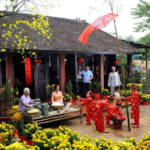The 15th day of the first lunar month, known as Tet Nguyen Tieu, is a significant holiday for many Vietnamese, rooted in their faith and traditions. But what is the origin of this festival, and what does it signify? Let’s explore its history, significance, and how it’s celebrated in Vietnam and other parts of the world.
1. What is Tet Nguyen Tieu?
 The Origin of Tet Nguyen Tieu
The Origin of Tet Nguyen Tieu
Tet Nguyen Tieu, also known as the 15th day of the first lunar month, is a festival originating from China and lasting from the 14th to the 15th day of the first lunar month. According to Dr. Dinh Duc Tien, from the University of Social Sciences and Humanities, Tet Nguyen Tieu stems from various Chinese legends.
2. The Legend and Significance of Tet Nguyen Tieu
The Legend of Tet Nguyen Tieu
Numerous historical documents trace the origins of Tet Nguyen Tieu to the Western Han Dynasty in China, marked by a grand lantern festival. The story revolves around the court ladies, who longed to visit their families during spring but were confined within the strictly guarded palace. Dong Phuong Soc, a favored courtier of Han Wu Di, was touched by their plight. He devised a plan to spread news that the Fire God would raze the city of Chang’an, causing widespread fear. He then proposed to the Emperor that they should evacuate the palace on the 15th day of the first lunar month, setting lanterns ablaze to deceive the Fire God.
Han Wu Di agreed to this strategy, and thus, every year on the 15th day of the first lunar month, the entire nation would hang lanterns, allowing the court ladies to reunite with their families. This tradition has endured for centuries and spread to Vietnam, where it has evolved and differs from its Chinese counterpart.
The Significance of Tet Nguyen Tieu
 Offering Rituals on Tet Nguyen Tieu
Offering Rituals on Tet Nguyen Tieu
Tet Nguyen Tieu translates to “the first full moon night of the new year”, with “Nguyen” meaning “first” and “Tieu” meaning “night.” It is also referred to as Tet Thuong Nguyen to distinguish it from Tet Trung Nguyen (the 15th day of the seventh lunar month) and Tet Ha Nguyen (the 15th day of the tenth lunar month). This day holds special significance for Buddhists, as reflected in the saying, “A year’s worth of offerings doesn’t equal the offering on the first full moon night” and “Praying to the Buddha all year doesn’t equal praying on the first full moon night.”
Families usually prepare an offering tray to express their reverence and gratitude to the Buddha and their ancestors, wishing for a prosperous and fortunate new year. The specific offerings may vary depending on economic conditions and regional customs, but they all share the common purpose of paying homage to the Buddha and their ancestors.
Reference: 15 3 Regions, 3 Unique Ways to Seek Luck for the New Year
3. Customs and Celebrations of Tet Nguyen Tieu in Different Countries
Tet Nguyen Tieu in Vietnam
In Vietnam, Tet Nguyen Tieu falls on the 15th day of the first lunar month, and it is when people go to temples to pray for good fortune and to have their fortunes told. In areas with a large Chinese community, such as Cho Lon and Hoi An, Tet Nguyen Tieu is marked by various special activities and festivals.
In District 5 of Ho Chi Minh City, the Chinese community organizes diverse and vibrant festivals at their family homes and association halls. These include rituals, parades, traditional opera performances, lion and dragon dances, riddles, calligraphy, painting, and musical performances.
 In Vietnam, Buddhists from all over the country visit temples on this day to pray for peace and prosperity.
In Vietnam, Buddhists from all over the country visit temples on this day to pray for peace and prosperity.
Tet Nguyen Tieu in China
In China, Tet Nguyen Tieu is known as Tet Thuong Nguyen or Tet Trang Nguyen. People make offerings to pray for peace and blessings, eat “thang vien” (floating balls in water), guess the shapes on lanterns, compose poems, and write wishes on lanterns before releasing them into the sky.
Tet Nguyen Tieu in Other Countries
In South Korea, the 15th day of the first lunar month is celebrated as Daeboreum, and people engage in traditional games like Samulnori (쥐불 놀이) and the Jeongwol Daeboreum Fire Festival the night before Daeboreum. They also climb mountains to be the first to see the rising moon and wish for good luck.
In Japan, this day is known as 小 正月 (Koshōgatsu), and people pray for a bountiful harvest and eat red bean porridge in the morning.
The Philippines marks this day with colorful parades.
4. Frequently Asked Questions About Tet Nguyen Tieu
When is Tet Nguyen Tieu in 2024 according to the solar calendar?
Tet Nguyen Tieu takes place from the evening of the 14th (the night before the full moon) to the end of the 15th (the full moon) of the first lunar month. Many people take leave from work to visit temples and pray for peace and success in the new year. In 2024, Tet Nguyen Tieu falls on February 24th, a Saturday, on the solar calendar, making it convenient for people to visit temples and pay their respects to the Buddha and their ancestors.
When is the offering ceremony for the 15th day of the first lunar month in 2024 according to the solar calendar? The 15th day of the first lunar month is Tet Nguyen Tieu, so the offering ceremony will be held on Saturday, February 24, 2024, on the solar calendar.
 Tet Nguyen Tieu 2024 according to the solar calendar
Tet Nguyen Tieu 2024 according to the solar calendar
What is the difference between Tet Nguyen Tieu of the Chinese and the Vietnamese?
Tet Nguyen Tieu was introduced to Vietnam during the period of Northern domination and has since evolved due to the influence of Vietnamese customs and traditions. For the Chinese, this day is marked by lantern festivals and releasing lanterns with wishes for a peaceful new year. In Vietnam, on the other hand, Buddhists from all over the country visit temples on this day to pray for peace and prosperity. Temples often hold Duyen Thuong ceremonies, reciting Duyen Thuong sutras throughout the first lunar month, and encouraging Buddhists to join in the prayers for blessings and peace in the new year.
What food is traditionally eaten during Tet Nguyen Tieu?
In China, people eat “thang vien” (floating balls in water), ha cao (shrimp dumplings), red apple cakes, mantou (steamed buns), and oatmeal cakes to wish for good luck and health.
In Vietnam, people eat “banh u” (sticky rice dumplings), “banh chung” (square sticky rice cakes), “xoi gac” (red sticky rice), and boiled chicken, among other dishes, hoping for happiness, warmth, and prosperity for their families.
How should we offer prayers on the 15th day of the first lunar month?
The best day to offer prayers for the 15th day of the first lunar month in 2024 is the morning of February 24th, 2024 (the 15th day of the first lunar month), but if you’re occupied, you can also offer prayers on February 23rd, 2024 (the 14th day of the first lunar month). The most auspicious time for the ceremony is at noon.
For the offering ceremony, prepare one tray for the Buddha and another for your ancestors, and make sure to clean the altars thoroughly to avoid any breakage.
Reference: : Offering Prayers and Incantations for a Fortunate Year
 Offering Prayers on the 15th Day of the First Lunar Month
Offering Prayers on the 15th Day of the First Lunar Month
We hope that through this article, you have gained a deeper understanding of Tet Nguyen Tieu, a significant festival in Vietnamese culture. May you and your family find peace and prosperity as you visit temples to pray for a blessed new year.
Explore 12 Amazing Destinations for Biking Trips
Unlock Vietnam in a brand new way with an exciting biking tour! Discover the stunning beauty of the country with Dien May XANH’s top 12 must-see destinations. From sweeping plains to clear blue beaches and mountainous vistas – experience all the sights with your own personal cycling tour. Find your ideal route and set out for an adventure today!







































